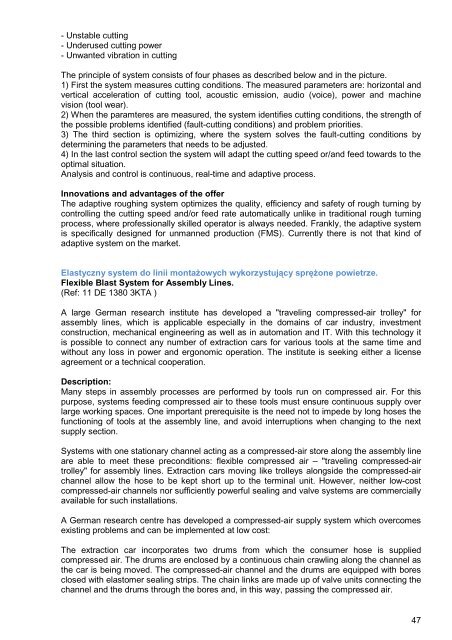Katalog firm - Eurotool 2011 - Centrum Transferu Technologii
Katalog firm - Eurotool 2011 - Centrum Transferu Technologii
Katalog firm - Eurotool 2011 - Centrum Transferu Technologii
You also want an ePaper? Increase the reach of your titles
YUMPU automatically turns print PDFs into web optimized ePapers that Google loves.
- Unstable cutting<br />
- Underused cutting power<br />
- Unwanted vibration in cutting<br />
The principle of system consists of four phases as described below and in the picture.<br />
1) First the system measures cutting conditions. The measured parameters are: horizontal and<br />
vertical acceleration of cutting tool, acoustic emission, audio (voice), power and machine<br />
vision (tool wear).<br />
2) When the paramteres are measured, the system identifies cutting conditions, the strength of<br />
the possible problems identified (fault-cutting conditions) and problem priorities.<br />
3) The third section is optimizing, where the system solves the fault-cutting conditions by<br />
determining the parameters that needs to be adjusted.<br />
4) In the last control section the system will adapt the cutting speed or/and feed towards to the<br />
optimal situation.<br />
Analysis and control is continuous, real-time and adaptive process.<br />
Innovations and advantages of the offer<br />
The adaptive roughing system optimizes the quality, efficiency and safety of rough turning by<br />
controlling the cutting speed and/or feed rate automatically unlike in traditional rough turning<br />
process, where professionally skilled operator is always needed. Frankly, the adaptive system<br />
is specifically designed for unmanned production (FMS). Currently there is not that kind of<br />
adaptive system on the market.<br />
Elastyczny system do linii montaŜowych wykorzystujący spręŜone powietrze.<br />
Flexible Blast System for Assembly Lines.<br />
(Ref: 11 DE 1380 3KTA )<br />
A large German research institute has developed a "traveling compressed-air trolley" for<br />
assembly lines, which is applicable especially in the domains of car industry, investment<br />
construction, mechanical engineering as well as in automation and IT. With this technology it<br />
is possible to connect any number of extraction cars for various tools at the same time and<br />
without any loss in power and ergonomic operation. The institute is seeking either a license<br />
agreement or a technical cooperation.<br />
Description:<br />
Many steps in assembly processes are performed by tools run on compressed air. For this<br />
purpose, systems feeding compressed air to these tools must ensure continuous supply over<br />
large working spaces. One important prerequisite is the need not to impede by long hoses the<br />
functioning of tools at the assembly line, and avoid interruptions when changing to the next<br />
supply section.<br />
Systems with one stationary channel acting as a compressed-air store along the assembly line<br />
are able to meet these preconditions: flexible compressed air – "traveling compressed-air<br />
trolley" for assembly lines. Extraction cars moving like trolleys alongside the compressed-air<br />
channel allow the hose to be kept short up to the terminal unit. However, neither low-cost<br />
compressed-air channels nor sufficiently powerful sealing and valve systems are commercially<br />
available for such installations.<br />
A German research centre has developed a compressed-air supply system which overcomes<br />
existing problems and can be implemented at low cost:<br />
The extraction car incorporates two drums from which the consumer hose is supplied<br />
compressed air. The drums are enclosed by a continuous chain crawling along the channel as<br />
the car is being moved. The compressed-air channel and the drums are equipped with bores<br />
closed with elastomer sealing strips. The chain links are made up of valve units connecting the<br />
channel and the drums through the bores and, in this way, passing the compressed air.<br />
47


